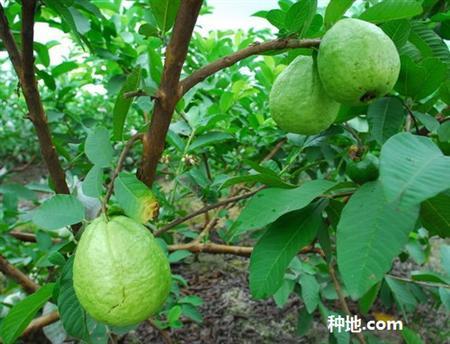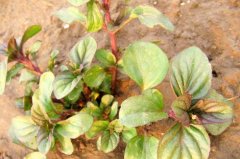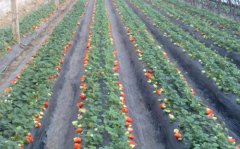How to cultivate guava: cultivation techniques and planting time of guava
Organic cultivation of guava
Selection and Maintenance of Environmental Conditions
Guava is one of the most important tropical fruit trees cultivated in central and southern Taiwan. Organic cultivation of guava must first have good environmental conditions, and the selected orchards must not have air pollution, water pollution and soil pollution. In the farming process, chemical fertilizers and chemical pesticides are not used at all or as little as possible, but various plant residues, livestock manure, green manure and other unpolluted organic wastes inside and outside the farm, natural ore powder and beneficial microorganisms are fully utilized to avoid damaging soil, water resources and ecological environment, so as to maintain sustainable agricultural production and provide guava with high quality and high safety, which is beneficial to human health. The cultivation method without chemical fertilizers and chemical pesticides is called pure organic farming method, and the cultivation method with less chemical fertilizers and chemical pesticides is called quasi-organic farming method. However, a small amount of chemical fertilizers and chemical pesticides in quasi-organic farming method are recommended to be used from harvest to flowering. Natural control methods should be adopted after the results are obtained, and the products should not have any chemical pesticide residues. Because guava has few pests and diseases, and blossoms and bears all year round, young fruit, middle fruit and fruit are all on the same tree, so it is best not to use chemical pesticides at all, but in order to improve its taste quality, inorganic nutrients such as phosphate-potassium, acid-calcium and magnesium phosphate must be used appropriately. If managed according to the above method, it should be called quasi-organic farming method without chemical pesticides.
Cultured from grass without herbicides
Guava is very easy to suffer from diseases and die. Generally, there will be some guava plants that die due to diseases every year. After plucking and replanting, the new seedlings will still die again. The main reason is that the bacteria have already been retained in the soil and can invade the guava plants at any time. As the guava gardens are generally plowed, herbicides are used to remove weeds, so that guava trees are very weak, leaves are easy to yellow, and the phenomenon of dead plants is more serious. The general control method is to dig out the dead plants and plant corn or sorghum and other gramineous crops on the site, and then plant guava to grow normally, but the best method is to collect grass and cultivate. Since most of the grasses are Gramineae, their roots can not only soften the orchard soil gradually, but also eliminate soil nematodes and pathogens. In the future, as long as a large amount of organic fertilizer, lime and other soil improvement materials are applied to the grass, they can gradually penetrate downward and be absorbed by fruit trees. When picking and cultivating grass, we should try our best to eliminate wild weeds such as grass, sia, aria, wild morning glory, etc., leaving mild weeds such as grass, grass, carpet grass, etc., so that earthworms and other beneficial microorganisms and small organisms in the soil can naturally reproduce, and the soil will gradually become soft for fertilization and normal growth of crop roots and absorption of nutrients. If the weeds are too high, use machinery to cut them off. Do not use any herbicides. If the native dwarf clematis is fully planted, it can be completely mowed year-round. The local dwarf clematis was first successfully tested by Liu Yongfu, a farmer in Shetou Township. The stem of the grass is very small and the plant will never grow too tall. Liu Nongyou selected it himself.

fertilization management
Because guava will bear fruit every time it grows new buds, it can be said that in general orchards, except for a short period of time after heavy pruning, it will bear fruit almost all year round. There are young fruits, medium fruits and fruits on a tree. The fertilization management method is very different from that of flowering once or twice a year. If a large amount of nitrogen is often used to promote the growth of young fruits, the sugar content of fruits will be reduced. If a large amount of nutrients such as phosphorus, potassium, calcium and magnesium are used to increase the sugar content of the fruit and nitrogen is ignored, the fruit will not grow. The best way is to avoid requiring too large fruit grains and fully supply nutrients such as phosphorus, potassium, calcium and magnesium under the principle of appropriate control of nitrogen fertilizer. Fertilization methods can be divided into basal fertilizer and topdressing:
Basal fertilizer is usually applied in May-June after heavy shearing, and then applied with bagasse, rice, sawdust and other coarse organic and pig manure, cow dung, sheep dung, feathers, oil meal (soybean meal, peanut meal, sesame meal, rapeseed meal, hemp meal, etc.), rice bran, phosphate rock powder, peat, comprehensive beneficial microorganisms and other organic fertilizer, in addition to the full use of phosphate rock powder, oyster shell powder, limestone powder, dolomite powder or other calcium and magnesium materials, at this time the amount can be a little more.
The method for preparing the medium nitrogen oil cake liquid fertilizer comprises the following steps: preparing a 120 liter plastic barrel, adding 3 kilograms of soybean powder, 6 kilograms of rice bran, 3 kilograms of phosphate rock powder or guano faeces, 2 kilograms of seaweed powder, 1 liter of animal amino acid, 3 eggs, 10 kilograms of brown sugar, 2 liters of comprehensive beneficial microorganisms, finally adding clean water to about 100 liters, fully mixing, stirring once a day in the morning and evening to make the acid fermentation about 15-30 days, taking out the stock solution, diluting 50 times with water, adding humic acid 1000 times or other nutrients, and irrigating the roots together. When spraying leaves, soybean powder is used, and rice bran condensed milk is used instead. After the preparation, soybean powder can be diluted 100 times with water and sprayed on leaves. If the trees are already bearing fruit, apply about 30 kg oyster shell ash or slaked lime, bitter lime or other calcium and magnesium materials once a month. These materials are best applied before liquid fertilizer irrigation or when the soil is wet after rain.
pest control
Guava is a wild fruit tree with few pests and diseases, but if it is not properly controlled, it is almost impossible to obtain any benefits. Its main diseases are blight, blight and anthracnose. Insect pests are fruit flies, mealy scale insects, aphids, rust, thrips and so on. Rhizoctonia solani is mainly transmitted from wounds, so after cutting, the wounds can be smeared with wood tar and sprayed with 200-300 times Bordeaux solution immediately. The dead guava plants are pulled out and burned, and the disease is transmitted from the soil to damage fruit grains, seedlings, branches and leaves. Therefore, after the diseased plants are pulled out, corn, sorghum or other gramineae plants can be planted on the site, or local dwarf clematis grass can be planted for grass cultivation, so as to avoid its damage. Newly planted seedlings are easier to survive. Anthracnose control: spray 400-500 times Bordeaux mixture and 300-500 times Melia azedarach oil once a month in flowering and fruiting period, or spray 600-800 times lime sulfur mixture once every 15-30 days, spray 400 times sweet and sour solution every 7-14 days (Brown sugar enzyme or comprehensive beneficial microorganisms and brewing vinegar each 400 times) can also reduce the occurrence of various diseases and insect pests, which brewing vinegar if you can soak about 20% of garlic and pepper, etc., the effect will be better.
Anthracnose control can be appropriate spray lime sulfur mixture and Bordeaux mixture.
Fruit flies are the biggest pest of guava. If they are not controlled, there will be no harvest at all. The only control method is to bag them as soon as possible. However, rust flies will breed in the package after packaging, causing brown to red spots on the peel of guava. By about 25 times magnification, you can see that the insects that look like white rice and have six legs are rust flies. Control methods Spray 300-400 times of wettable sulfur powder or 500-600 times of lime sulfur mixture before assembly and soak the bag in wettable sulfur powder and let it dry before use.
Mealyscale insect is the second largest pest of guava. If it is not controlled, it will produce a lot of white powder on the fruit or branches, which will affect the growth and appearance quality of guava. Because the powder scale insects and aphids and ants are symbiotic state, ants in order to obtain molasses are in full protection powder scale insects and aphids, so to prevent scale insects and aphids, should try to control ants first, control ants can spray high concentrations of stained substances such as summer oil and turpentine, etc., these things such as adding pepper, tobacco, neem oil, citronella oil, mint oil and other effects are better, but to spray branches and leaves when the concentration should be appropriately reduced, at least should be more than 500 times.
For the control of powdery scale insects, mainly spray high-grade summer oil, add citronella oil, neem oil, etc.
Thrips damage mainly in flowering and young fruit stage, and the damaged fruit skin will produce rough phenomenon. Pyrethrum has good effect on thrips control. When pyrethrum is not available, citronella oil and mint oil are mixed and sprayed at 500-600 times each. Garlic, pepper, tobacco and neem oil are added to enhance the effect.
- Prev

How to plant grass flowers: vanilla cultivation techniques, what are the key points of vanilla cultivation?
Organic cultivation and utilization of vanilla plants the key points of organic cultivation and management of vanilla 1. Cultivation and selection of vanilla seedlings is very important to the selection of seedlings, and the good quality of seedlings has a great influence on the growth and flowering status of plants in the future, the so-called "half-cropping", that is,
- Next

Strawberry planting techniques and strawberry cultivation methods, strawberry cultivation and management techniques
(1) the combination of environmental selection and relevant measures, the implementation of soil rotation, the implementation of soil diagnostic analysis, soil improvement, no pollution of soil, air and water sources. (2) weed control methods to weed control by artificial or mechanical ploughing and weeding without the use of chemical herbicides. Adopt a cover or wheel
Related
- A one-day flower show brings 130 million yuan in orders! Nanhai, this Phalaenopsis exhibition is amazing
- What do the flower language and meaning of Lutheran tree mean? Precautions for planting Lutheran tree
- Encounter Chaoshan Kongfu tea, not without this cup of Phoenix single clump
- The durian market in Vietnam and Thailand is flooded. The price of imported durian has plummeted by 30-40% in a month.
- Shanghai solved the problem of local vegetable supply by planting 80,000 mu of green leafy vegetables.
- Wageningen University has become the best agricultural university in the world for the seventh time in a row.
- The strongest export season of South African grapes is full of challenges, with exports to Russia falling sharply by 21%.
- Sri Lanka is on the verge of bankruptcy, "Tea for debt" Organic Agriculture Revolution aggravates the Food crisis?
- Turning waste into earthworm manure and worm manure into organic fertilizer-A new choice for auxiliary farming
- Organic rice growers shoulder the responsibility of nurturing agricultural talents! Yinchuan Sustainable Farm with Organic Life Camp

